The canal / narrowboat thread.
Discussion
Chrisgr31 said:
SimonTheSailor said:
Oh dear - wonder if the rescue company are liable for this ?
https://youtu.be/G-tGoRoOG-8?si=jX-8qi1hVQZeIVZP
Its slightly surprising they ever thought that was going to work. Might be seen as being wise after the event but I would assume that the lower parts of a narrow boat are much heavier than the top parts, so tugging it from the top of the bow is asking for trouble.https://youtu.be/G-tGoRoOG-8?si=jX-8qi1hVQZeIVZP
Having said that the options were limited anyway because as the water level dropped it was going to struggle to stay on the buttress.
I think the one this week (the blue one) rolled all by itself after spending a few days wedged.
'My' site features in the first few seconds of this video. The building stayed dry but the flood back it's on didn't really work
https://m.youtube.com/watch?v=yCBWsIyWsqk&si=J...
https://m.youtube.com/watch?v=yCBWsIyWsqk&si=J...
mcdjl said:
That's not the boat the rescue story is about- check the dates and boat colours.
I think the one this week (the blue one) rolled all by itself after spending a few days wedged.
If you watch the video linked the boat in the video rolled after a rescue attempt that aimed to pull it off from the bow.I think the one this week (the blue one) rolled all by itself after spending a few days wedged.
Subsequently I have seen a follow up video by the same You Tuber who says its possible it would have rolled by itself as the water level fell. https://www.youtube.com/watch?v=q_NCaOMFNNI
Chrisgr31 said:
mcdjl said:
That's not the boat the rescue story is about- check the dates and boat colours.
I think the one this week (the blue one) rolled all by itself after spending a few days wedged.
If you watch the video linked the boat in the video rolled after a rescue attempt that aimed to pull it off from the bow.I think the one this week (the blue one) rolled all by itself after spending a few days wedged.
Subsequently I have seen a follow up video by the same You Tuber who says its possible it would have rolled by itself as the water level fell. https://www.youtube.com/watch?v=q_NCaOMFNNI
mcdjl said:
That's not the boat the rescue story is about- check the dates and boat colours.
I think the one this week (the blue one) rolled all by itself after spending a few days wedged.
Ah yes sorry - the first link was a boat that sunk earlier this year, the second link was a boat that sunk recently.I think the one this week (the blue one) rolled all by itself after spending a few days wedged.
SimonTheSailor said:
I would have thought that had it been left it just would have slid off away from the bridge when the water dropped far enough ?
A narrow boat is flat bottomed so isn't going to get 'hooked up' on anything.
In this case the bridge has buttresses and isn't smooth. These were taken over a couple of days, the water is still at least 1ft higher than normal. I didn't realise it when I first saw pictures but it belongs to a friend of a friend.A narrow boat is flat bottomed so isn't going to get 'hooked up' on anything.
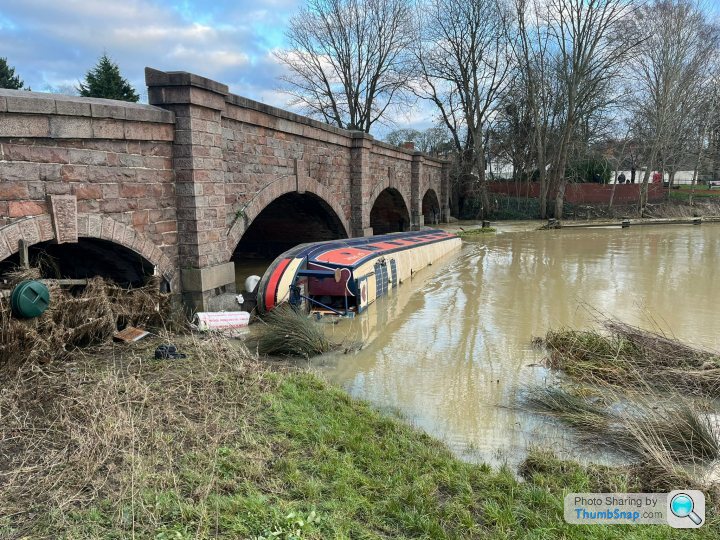
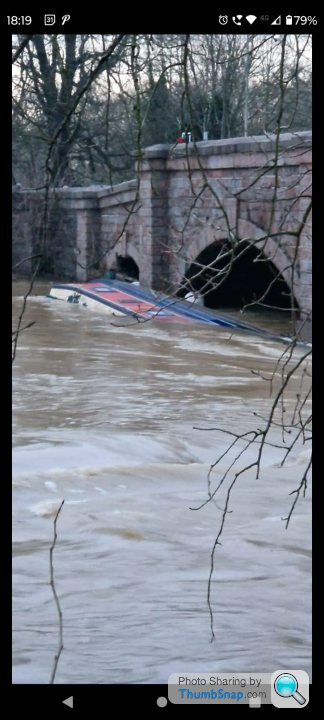
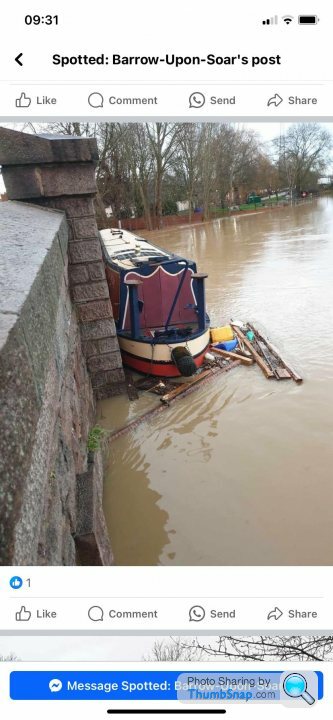
mcdjl said:
SimonTheSailor said:
I would have thought that had it been left it just would have slid off away from the bridge when the water dropped far enough ?
A narrow boat is flat bottomed so isn't going to get 'hooked up' on anything.
In this case the bridge has buttresses and isn't smooth. These were taken over a couple of days, the water is still at least 1ft higher than normal. I didn't realise it when I first saw pictures but it belongs to a friend of a friend.A narrow boat is flat bottomed so isn't going to get 'hooked up' on anything.



In the early 1970's my parents lived in Acton Trussell alongside the Staffs And Worcs canal with a cruiser at the bottom of the garden. Other side of the cut was the river Penk, then J13 of the M6 around half a mile over the fields. Every winter the river flooded....however the canal level remained constant....perhaps the lesson here is for liveaboarders to take to the canal system over the winter?
Or at least move onto a floating jetty?
The Broads network here in Norfolk is currently at a very high level, gardens flooding at Potter Hiegham and in other places as happens when lots of rain falls out of the sky...local planners will not allow living accomodation at ground level alongside the rivers for this reason, it all has to be up on stilts or above a wet boat shed.
ferret50 said:
perhaps the lesson here is for liveaboarders to take to the canal system over the winter?
Or at least move onto a floating jetty?
You couldn't just move a load of 70' narrowboats from regular moorings on a river to random bits of canal towpath; they'd take up too much room and there's probably a time limit.Or at least move onto a floating jetty?
Floating jetties are ideal but would cost more than normal moorings (which are often just bankside) and many liveaboards are occupied by people not of excessive wealth, if you know what I mean. Boating on a shoestring is going to have its problems.
The article says 'Torrential rain and surging water caused the boat to break its moorings' and part of the moorings broke away. If this was a liveaboard, were they on board at the time?
Edited by Simpo Two on Monday 8th January 11:02
Simpo Two said:
ferret50 said:
perhaps the lesson here is for liveaboarders to take to the canal system over the winter?
Or at least move onto a floating jetty?
You couldn't just move a load of 70' narrowboats from regular moorings on a river to random bits of canal towpath; they'd take up too much room and there's probably a time limit.Or at least move onto a floating jetty?
Floating jetties are ideal but would cost more than normal moorings (which are often just bankside) and many liveaboards are occupied by people not of excessive wealth, if you know what I mean. Boating on a shoestring is going to have its problems.
The article says 'Torrential rain and surging water caused the boat to break its moorings' and part of the moorings broke away. If this was a liveaboard, were they on board at the time?
Edited by Simpo Two on Monday 8th January 11:02
Back in the '70's I was stationed at RAF Wittering and was thinking of living aboard a boat on the Nene, mentioned it to the family and my mother suggested checking out my proposed mooring in the winter.....it was under several feet of water....so I bought a scruffy stone cottage to 'do up' instead!
The moorings I suspect that boat came from are flood hot at least once a year. These floods were beyond the normal levels by some margin. It's probably lucky only one boat went. The other side of the pilings food lock another live aboard on the canal section has gone down (tied too tight) so the canal level didn't stay level. Plus with it being the soar navigation a lot of it is river rather than canal as such.
Reading a bit more about it, whatever it was attached to - 'the mooring' - also went with it so various bits of wood/poles were still attached to the boat. They could have been under the bridge wedged in a certain way maybe ?
Agreed that rivers aren't the best place to be over winter, but some areas are better than others. Some might rarely get flooded but can still have flash floods.
I was down in Maidenhead/Windsor last winter, told myself it was best to get back to the canals but circumstances meant I didn't. There is a relief channel built now around Maidenhead so the town doesn't get flooded like it once did, but the river flows fast through there still (a few knots) so I got stuck there for 2/3 months. Lesson learnt.
Agreed that rivers aren't the best place to be over winter, but some areas are better than others. Some might rarely get flooded but can still have flash floods.
I was down in Maidenhead/Windsor last winter, told myself it was best to get back to the canals but circumstances meant I didn't. There is a relief channel built now around Maidenhead so the town doesn't get flooded like it once did, but the river flows fast through there still (a few knots) so I got stuck there for 2/3 months. Lesson learnt.
SimonTheSailor said:
Reading a bit more about it, whatever it was attached to - 'the mooring' - also went with it so various bits of wood/poles were still attached to the boat. They could have been under the bridge wedged in a certain way maybe ?
Agreed that rivers aren't the best place to be over winter, but some areas are better than others. Some might rarely get flooded but can still have flash floods.
I was down in Maidenhead/Windsor last winter, told myself it was best to get back to the canals but circumstances meant I didn't. There is a relief channel built now around Maidenhead so the town doesn't get flooded like it once did, but the river flows fast through there still (a few knots) so I got stuck there for 2/3 months. Lesson learnt.
I would describe those waterways as 'canalised rivers', they have locks to control the depth and flow of water but do not prevent flooding or slow the flow down, once the rain starts it has to go somewhere!Agreed that rivers aren't the best place to be over winter, but some areas are better than others. Some might rarely get flooded but can still have flash floods.
I was down in Maidenhead/Windsor last winter, told myself it was best to get back to the canals but circumstances meant I didn't. There is a relief channel built now around Maidenhead so the town doesn't get flooded like it once did, but the river flows fast through there still (a few knots) so I got stuck there for 2/3 months. Lesson learnt.
The example I gave upthread was a 'proper' canal compared to a small local river, not a navigable river.
Before the parents bought near Stafford, they looked at a place in Evesham on the side of the Avon, the 'river garden' across the main road was off putting, but the 12' high mooring poles were the final straw to that one, and this was some 50 years back....so flooding is not new to navigable rivers.
ferret50 said:
Before the parents bought near Stafford, they looked at a place in Evesham on the side of the Avon, the 'river garden' across the main road was off putting, but the 12' high mooring poles were the final straw to that one, and this was some 50 years back....so flooding is not new to navigable rivers.
Indeed not; I remember once about 1980 navigating my father's boat along the Great Ouse near St Ives. The river was completely over the banks on both sides so we stayed between the marker poles (if you strayed across a field you could run aground which would be embarrassing when the water went down!). There were no 'strong stream warnings' or texts, we just assessed the situation and used common sense.If people lived on that narrowboat, why didn't they go out and check/adjust the ropes as the water rose? It may have been the upward force of the boat that pulled the (possibly ramshackle) mooring apart.
journeymanpro said:
SimonTheSailor said:
A narrow boat is flat bottomed so isn't going to get 'hooked up' on anything.
They get hooked up rather easier than you would think. Flat bottom is just that, a large flat area, with a hard chine, and lots of opportunity to catch on even small ledges compared to a round bottom boat, or one with even moderate sized hard chines at 45 deg or similar. Almost all narrowboats are also built with the sides sitting on the base plate, so there is a protrusion of base plate beyond the side plates just read to stick on something! Typically there is a very very mild chine, a shallow bend 6inches up sucking the bottom edge in a tad, so the base plate isnt actaully the widest point and doesnt get suck in every single lock, in anything more then a half inch lip or a 5deg list is a serious risk.
If you look at the bridge, as is fairly typical, the foundation stones extend beyond the wall, a narrowboat coming down on those with the force of the river holding it tight, would I suspect roll over. Its very hard to see anyway in which it wouldn't without external help.
https://en.wikipedia.org/wiki/File:Barrow_upon_Soa...
At which point, time is off the essence, you might only have maybe a day from the level coming up to it dropping again, and often it will then drop in a few hours. Obviously often the wider country is effected at the same time, resources are finite.
That said, I am not at all surprised that the winching ended the way it did sadly. With some weirs and certain bridges you might have the option to winch it along the bridge rather than away from it, but that wouldnt have worked here. Boats don't have nice handy winch points welded on, certainly not pre-attached recovery points from the chassis rails and in through the passenger window like you would on modified change spec off roader!
At which point you are talking about trying to get a line under the boat, up the far side, and secured so a strong anchor point, so you can pull from the base plate. Easy said, but hard to effect, given you are not going to want to be on the boat let along in the water in those conditions.
If it was your own boat, and you had a relaxed attitude to your own end, maybe you could climb onto the boat and do it, certainly when the boat was more level it is something that I would have thought about rigging in advance of the winches arriving onsite, but once the crews arrived on site I dont think I would have been game for climbing down onto it and trying to introduce a rope under the boat and fish it up the gap between the bridge and the boat.
Bridge is unlikely to suitable for attaching winches, lines, or using as a craning platform. At which point you are going to need a bloody big crane and a road closure notice to get anything sort of meaningful lift on it which you are probably not going to be able to arrange fast enough.
Very sad end, but once its against the bridge, you really are up against the clock and the odds.
Simpo Two said:
If people lived on that narrowboat, why didn't they go out and check/adjust the ropes as the water rose? It may have been the upward force of the boat that pulled the mooring apart.
We can only speculate, maybe they where on holiday, not physically able, thought it was well setup and would be ok. The river coming up isnt a new issue as said, so I am sure there would have been some provision for accommodating flooding, but a Rolls Royce commercial spec rising mooring and anchoring systems are rare on the inland waterways and would cost as much as the boat, so more often its a reasonably put together but far from infallible set of braced scaffolding poles or similar.We ended up caught out with our boat earlier this year, left it a week too long on the Weaver after the Leigh Arms steam gathering at Acton Bridge, and the levels came up while myself and our family where on holiday in the lake district. By the time it was becoming apparent how much the levels where going to come, short of leaving the family and driving through the night in the only car we had wit us, all I could do was contact some local friends, and hope for the best.
Coincidently, that's exactly what some friends of mine did do in similar circumstances a few years ago, to join a 24h waking watch on the boat yard for three days till the levels went down while their partner spend the rest of the holiday with two young children, no car, and a lot of rain!
dhutch said:
We ended up caught out with our boat earlier this year, left it a week too long on the Weaver after the Leigh Arms steam gathering at Acton Bridge, and the levels came up while myself and our family where on holiday in the lake district. By the time it was becoming apparent how much the levels where going to come, short of leaving the family and driving through the night in the only car we had wit us, all I could do was contact some local friends, and hope for the best.
This was the best data I could see from the Lakes, online live level data for the pound above ours, which peeked shortly before midnight on the Friday night. I was awake watching the graph, and hoping when I had tied her up on a warm first Sunday of October at the end of the weekend I had left enough slack not just for normal River fluctuation as I had intended, but significant flooding and levels potentially meters above normal. I could also see other levels which are recorded further up river (Dane and Weaver) as well as the pound below, but there is no sensor on the pound in question. I turned in at half 11 but didnt sleep well!
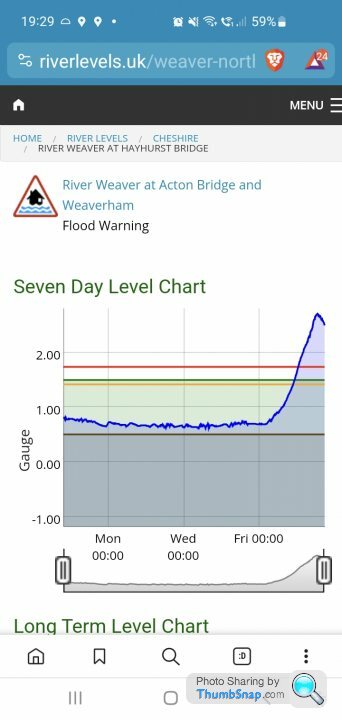
This is the morning after the levels went up, after my friend's loosened the lines and put additional lines out forward for me and send photos via whatapp. In the end three separate people checked in on the boat, two of which I had spoken to, a third who where in the area and called in on spec as they knew the boat was there a few days before.
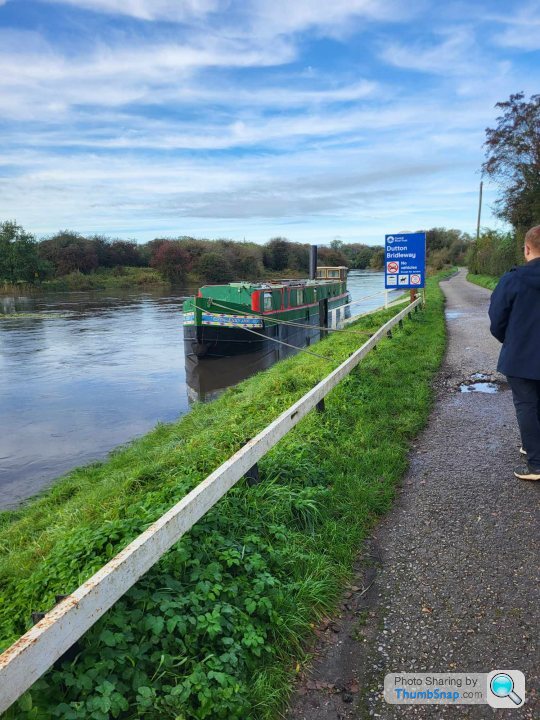
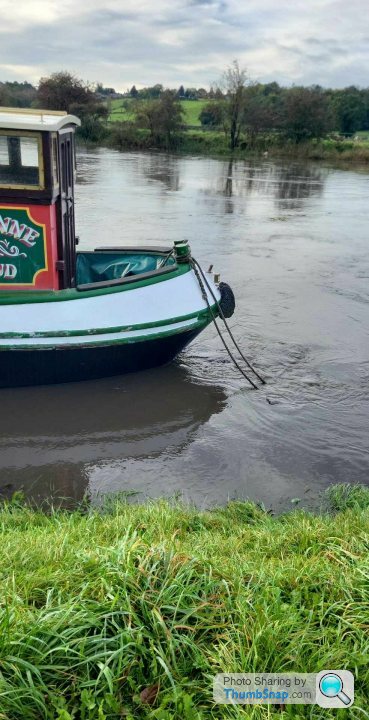
Not the best photo, but this is me early Saturday evening stood on the bank beside our boat while my wife waited with our sleeping toddler in the car, trousers rolled up, using my stocking feet to feel how close we where to riding over the top. Close!
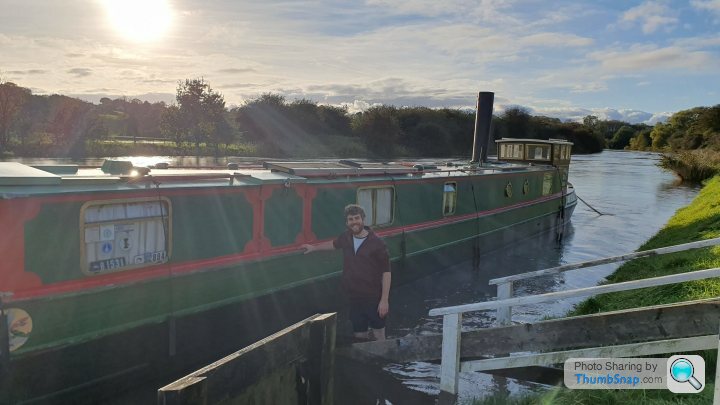
With help from the neighbouring house who happened to be a boat owner and landscape gardener, we jury rigged up arm to hold the boat out should the level rise further and exchanged contact details should I need to come urgently at any point. I didnt have keys to the boat with me, having come direct from the lakes enroute home.
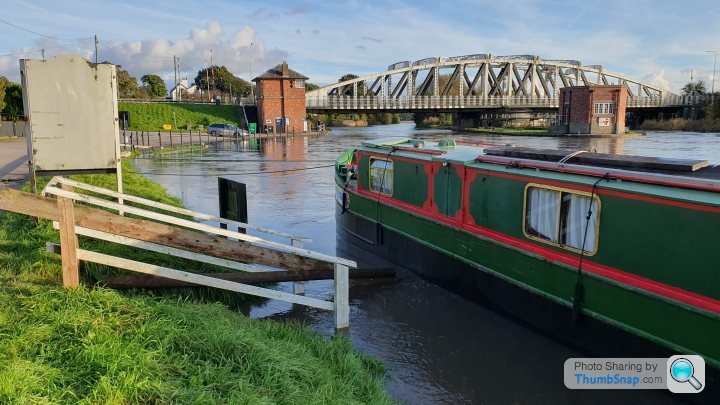
The carpark, showing the level appearing to be just on the turn! usually the bank here is over three foot high.

The following Morning. All but back to normal. Thanks to the kind neighbour for sending this.
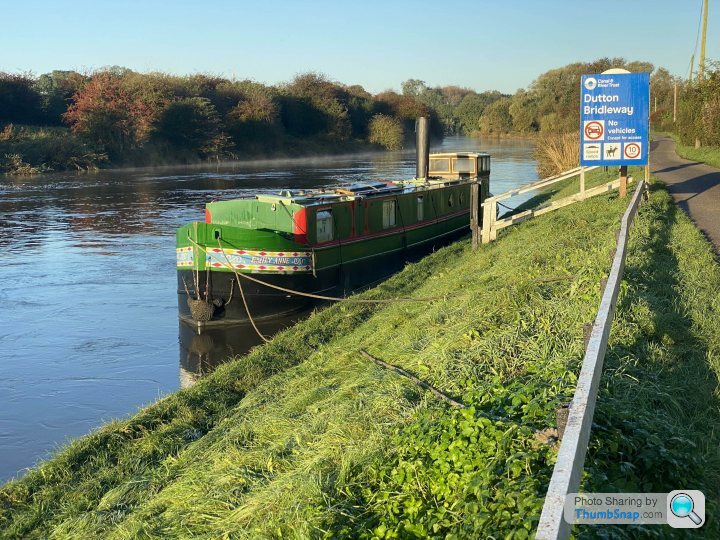
The bank at a normal level, calling in on the way to work Monday morning.
The stern was just still hanging on to the timber, the bow had ridden over and was riding on the 2inch of steel pulling left above it. Very close, too close really!
The boat draws around 2ft8 at the bow, so that's a rise of 1.3m. Hayhurst sensor (Northwich town centre) peeked at 2.15m, just slightly more than it did this week for Storm Henk.
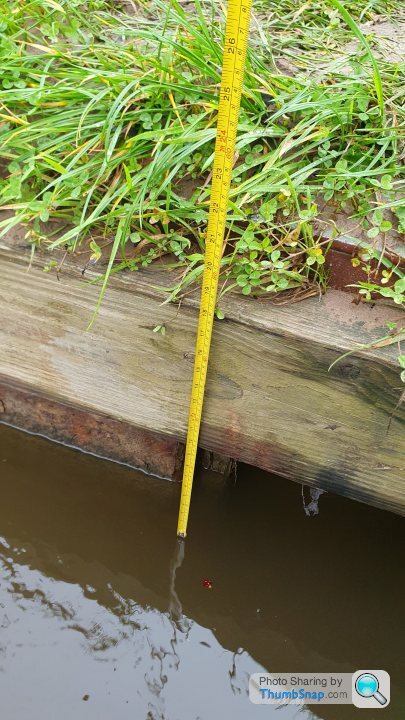
Gassing Station | Boats, Planes & Trains | Top of Page | What's New | My Stuff



